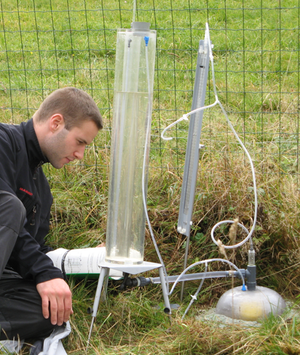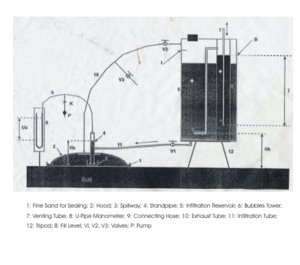Infiltration - Hood Infiltrometer
Parameter to be measured:
Infiltration capacity, unsaturated hydraulic conductivity, bubble pressure point
Method:
Tension-infiltrometer (UGT IL-2700): Measures infiltration rate within a hood that is placed onto soil surface. Hydraulic head within hood can be adjusted between 0 (=saturated conductivity) and bubbling pressure by means of a Mariotte-bottle. Newer versions provide a pressure sensor and data interface. The "logger" device comes in two versions: Rev1 the "logger" can only monitor the water table, Rev2 the logger really logs the water level in the reservoir and stores all experiments.
Equipment:
- main reservoir (with combined) Mariotte-bottle
- hood (various sizes), steel rim
- connecting tubes, manometer (e.g. U-style), hand pump
- datasheets, stop watch, sand (for sealing hood rim with soil surface)
- scissors for clipping vegetation
- spade (if levelling or deeper measurements are necessary)
- large water vessels for supply
Advantages:
- in-situ measurement, no analysis of disturbed soil samples in lab
- no contact layer with soil required (as with ceramic plates)
- works with reasonably uneven surfaces and original vegetation
- no need to drill neat holes (as with a constant head permeameter like the Amoozemeter) which is problematic in stony soils
Disadvantages:
- heavy, comes in huge metal suitcase (17 kg) (some wire straps may help connecting the many bits and pieces to a portable pack)
- large water consumption with sandy soils
- many pipes and valves - requires practice and understanding to recognise errors, set-up time
- lots of potentially leaky connections and many parts to loose in the field (bring silicone grease)
- at some locations it is difficult to get a suction head established as air enters the hood through macropores or root channels
- measurement in different depths of soil profile is complicated, though possible when digging pits
- price
What to watch out for:
potential problems with
- hydrophobic soils
- heterogenous water content of soil before measurement
- strong effects from preferential flowpaths
- strong swelling/shrinking of soil
- effects of impermeable layers before stationarity is achieved
- inclined, uneven surfaces
- inequivocal identification of stationary flow
(worksheet of H. Elsenbeer)
- insolation and temperature related problems
- in case of high macroporosity , use a metal ring with a larger depth to prefent the effect on the measurment than seal the hood with too much sand, because measurement area will in that case be error prone
Problems/Questions:
Links
no-frills-instruction (in German)
Projects that used the above equipment:
Other related web sites:
Punzelmeter at the University of Sydney
References
- Bens, O., Wahl, N.A., Fischer, H., Hüttel, R.F. 2007. Water infiltration and hydraulic conductivity in sandy cambisols: impacts of forest transformation on soil hydrological properties. Eur J Forest Res 126,101–109, DOI 10.1007/s10342-006-0133-7.
- Gardner, W.R., 1958. Some steady-state solutions of unsaturated moisture flow equations with application to evaporation from a water table. Soil Science 85, 228-232.
- Schwaerzel, K., Punzel, J., 2007. Hood infiltrometer - A new type of tension infiltrometer. SOIL SCIENCE SOCIETY OF AMERICA JOURNAL 71(5), 1438-1447, DOI: 10.2136/sssaj2006.0104.
- Wooding, R.A., 1968. Steady infiltration from a shallow circular pond. Water Resources Research 4, 1259-1273.

